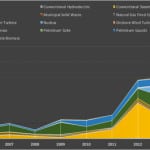Days after the North American Electric Reliability Corporation (NERC) warned in a new assessment that new federal air quality rules could stress the nation’s power grid, the Department of Energy (DOE) released its own report examining the potential impact of two standards on electricity reliability. Those rules would prompt the closure of 29 GW of coal-fired capacity, but they should not create resource adequacy issues or unmanageable reliability challenges, the DOE finds.
The report, titled “Resource Adequacy Implications of Forthcoming EPA Air Quality Regulations,” was an independent assessment by the DOE of the EPA’s July 2011 finalized Cross-State Air Pollution Rule (CSAPR) and the proposed Mercury and Air Toxics Standards (MATS). CSAPR will see the creation of multiple trading systems to control the emissions of nitrogen oxides (NOx) and sulfur dioxide (SO2) from power plants starting in 2012, and MATS will impose emissions rate standards on coal- and oil-fired power plant operators for mercury, acid gases, and particulate matter starting in 2015. The two rules, the DOE says, are expected to have the “greatest impact on the electric sector between now and 2015.”
The DOE said it recognized that compliance with the new rules would require installation of new pollution controls or construction of replacement generation—which could take multiple years to complete. In some cases, compliance could also be achieved through the use of existing controls, shifts in dispatch, purchase of allowances, and fuel switching, it said.
“Assuming prompt action by regulators and generators, the timelines associated with new construction and retrofit installations are generally comparable to EPA’s regulatory compliance timelines,” the report concludes. “If delays occur and if it is necessary to address localized reliability concerns, the Clean Air Act provides multiple mechanisms to extend these deadlines or bring sources into compliance over time on a plant-specific basis.”
The report analyzes a “stringent test case” in which uncontrolled electric generators are required to comply with CSAPR and install both a wet flue gas desulfurization (FGD) system and a fabric filter to reduce air toxic emissions. “If such installations are not economically justified, this scenario assumes that the plant must retire by 2015,” the DOE finds. However, the agency adds: “In reality, power plant owners will have multiple other technology options to comply with the regulations—options that typically cost less than installations of FGDs and fabric filters.”
The stringent test case projects that a total of 29 GW of coal capacity would be retired by 2015, but even with stringent assumptions, target reserve margins in each region could still be met. “Moreover, in every region but one [which is the Texas Reliability Entity (TRE)], no additional new capacity is needed to ensure resource adequacy in the Stringent Test Case beyond what is projected in the Reference Case.” For the TRE, the DOE finds that just a little less than 1 GW of new natural gas capacity would be needed by 2015 beyond additions already projected to occur.
The DOE’s findings compare with NERC’s Long-Term Reliability Assessment, which concluded that between 32.6 GW and 53.6 GW of capacity will retire by 2018 as a result of EPA regulations, causing available capacity to fall below target reserve margins in Texas and New England.
The DOE’s analysis also finds that the total amount of new capacity that would be added by 2015 is less than the amount that is already under development. Examining possible plant outages as a result of pollution control retrofit activity, the DOE concluded that resources would be sufficient in all regions “even when outages to tie-in pollution control retrofits were incorporated.”
While resource adequacy would not be compromised under CSAPR and MATS, “retirements of power plants or other factors could lead to grid reliability challenges in some cases,” the DOE warned, however. But even in these cases, federal and state governments can use “available regulatory and planning tools to address such reliability concerns as needed on a case-by-case basis. DOE is committed to providing technical assistance and working with stakeholders to ensure that the electric grid remains reliable as we strive to modernize the power sector,” it says.
Sources: POWERnews, DOE, NERC








